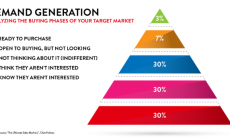Whether your website is a main channel for prospect acquisition and conversion or serves as a secondary sales tool, it’s vital that it’s conceived and organized to maximize its marketing effectiveness. Here are a few marks your site should absolutely be hitting.
Keep navigation simple
If your site’s main navigation–or the sub-menus within sections–require even a moment’s thought for site visitors to understand, you’re going to lose their attention and, ultimately, their eyeballs. Your prospects don’t care how clever or hip you are; they just want to find the information they’re after quickly and painlessly. Don’t create any barriers to doing so.
Define success
Your visitors want information and you want…what, exactly? If all you want out of your website is, well, having a website, congratulations. You’ve succeeded. That is, of course, setting the bar pretty low. Deciding whether you want visitors to sign up for your email newsletter, download a case study, or pick up the phone to call you, will be much more productive.
And in reality, you’ll want your visitors to do all of these things–just not at the same time. Your desired action will depend on where your visitor is in their buyer’s journey. Which brings us to:
Avoid indigestion
If your content isn’t presented in a digestible manner, the relief your visitors will be reaching for won’t be an antacid. It will be a competitor’s site. This means writing style, visual presentation, type size, and how well you’re breaking up content with white space, imagery, and other elements all have an impact. A solid presentation also has the benefit of eliminating the indigestion you’re likely to feel when presenting sub-par numbers to your C-suite each month.
Create content for different kinds of visitors
The tired, old story about not asking someone to marry you on the first date applies here. There is content (and associated calls-to-action) that works for first-time visitors, and content more appropriate to those who are already much closer to making their buying decision. Be sure you have all points in the funnel covered.
Don’t forget that you likely have multiple audience segments as well. Create content for each segment based on which of your solutions interests them and based on what aspect of any particular solution is most critical to their needs.
(My use of “solutions” above wasn’t an accident–your prospects don’t care about your products or services; they care about solutions to their problems.)
Make action obvious
With a broad range of content to cover all of your major audience segments and all potential positions along the buying process, you’ll want to be sure that your calls-to-action are obvious, simple, and uncluttered. Do all you can to limit each page on your site to a single, prominent call-to-action. Do all you can to make that call-to-action perfectly aligned with the content on the page. That’s the best way to maximize conversions.
Organize content from your visitors’ perspective
Content should be connected in a way that leads a visitor from one page to another, with each page building on the last to answer the questions a prospect is likely to have about your solution’s effectiveness and appropriateness. No content should be an island. And no content should be organized based on your company org chart or which department is responsible for what. Your content should be organized around your prospects’ needs. It’s just that simple.
This is where a well-configured CMS is worth its weight in gold–content can be published once and, through the use of tagging and categorization, appear wherever it is needed on the site. In each location it can be wrapped in supplemental material appropriate to that audience segment.
These basic ideas can take real effort to apply thoughtfully. Even then, they are no guarantee of success. (Though they do make success much more likely.) To be sure your site is succeeding, you’ll want to define KPIs (key performance indicators) and monitor them over time.





